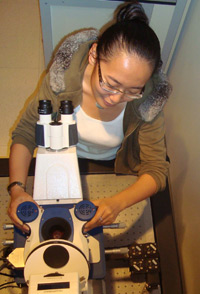JPK Instruments, a world-leading manufacturer of nanoanalytic instrumentation for research in life sciences and soft matter, reports on the use of their Tip Assisted Optics module by Dr Ralf Richter at the CIC biomaGUNE, Biosurfaces Unit in San Sebastian, Spain.
 PhD student, Xinyue Chen, works with the JPK NanoWizard AFM system in the group of Dr Ralf Richter in San Sebastian.
PhD student, Xinyue Chen, works with the JPK NanoWizard AFM system in the group of Dr Ralf Richter in San Sebastian.
CIC biomaGUNE is a non-profit research organization created in 2006 to promote scientific research and technological innovation at the highest levels in the Basque Country. Dr Ralf Richter leads Laboratory 3 in the Biosurfaces Research Unit applying a number of techniques for surface nanostructure characterization and biofunctionalization to guide the assembly of molecules down to the nanometer-scale. For this characterization, his group has developed a toolbox of biophysical in-situ techniques including a quartz crystal microbalance with dissipation monitoring (QCM-D), atomic force microscopy (AFM), reflection interference contrast microscopy (RICM), ellipsometry and fluorescence methods. The current research work is centered on biomolecular hydrogels, a broad class of materials that are produced in the human body or by other bioorganisms. They are assembled from proteins and glycans. They are typically very soft and contain a lot of water. Even though biomolecular hydrogels play crucial roles in many fundamental biological processes, we lack understanding about how they function. Of particular interest for the group's research are cellular coats that are rich in the polysaccharide hyaluronan which are important in processes such as fertilization, osteoarthritis and inflammation.
Dr Richter's group develops methods to re-create these specialized natural hydrogels through the controlled assembly from their molecular components in vitro. Functionalized surfaces are used to guide the self-assembly process. The resulting model films have the advantage that they can be better controlled and studied in much greater detail than the original materials. By doing so, the hope is to understand the fundamental mechanisms behind the assembly and functions of biomolecular hydrogels.
While AFM is used to obtain nanoscale topographic information about the self-assembled architecture of the materials created, AFM is also used to quantify the mechanical properties of these hydrogels. Dr Richter explains: "We employ colloidal probe AFM. When analyzing polymer films, a fundamental problem in colloidal probe AFM experiments is to determine the distance at closest approach between the probe and the substrate on which the film is deposited. In a study published earlier this year (Attili & Richter, Langmuir, 2012, 28:3206) we have overcome this problem by combining optical interferometry (RICM) and AFM in situ. With the combined setup, forces and absolute distances between substrate and probe can be measured at the same time. Thanks to its tip-assisted optics (TAO™) module and the integration of high-resolution optical microscopy, the combination of RICM and AFM can be readily setup with the JPK NanoWizard® system. By using our toolbox of techniques, we are able to combine their results to produce a very detailed picture about the physico-chemical properties and dynamics of the films of interest."
He continued: "I have worked with NanoWizard systems since 2005. I particularly like its robust design where the integration of the AFM with high resolution optical microscopy is made very straightforward to set up and use. I also like the versatile data acquisition and evaluation software. The combination of high resolution optical and atomic force microscopy is critical for the combination of AFM and RICM. Here, the tip-assisted optics (TAO) module is also very useful. It keeps the colloidal probe in the center of the optical image, while probing different spots on the same surface."